Forum Replies Created
-
AuthorPosts
-
 Bill WardParticipant
Bill WardParticipantHi,
Interesting, Colin, there may well be a Ti line or two in the spectrum…
Even at ~0.2nm/pix there are so many lines each could be several elements as many have lines extremely close to each other. I never really envisaged that I’d get results so good this would be a problem! Mmmm, be careful what you wish for…
The blue end…
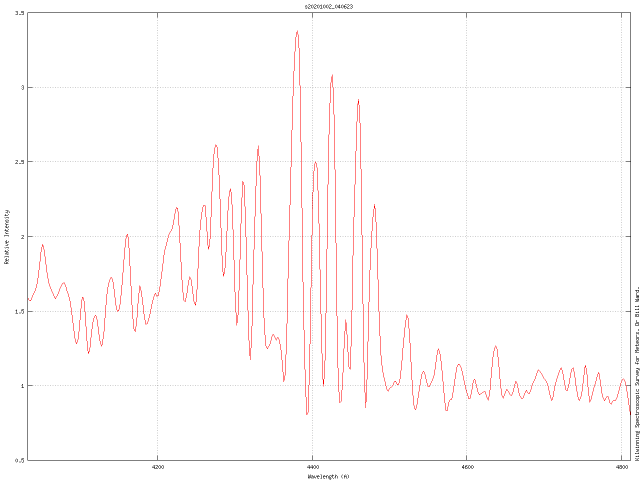
…and the green end…
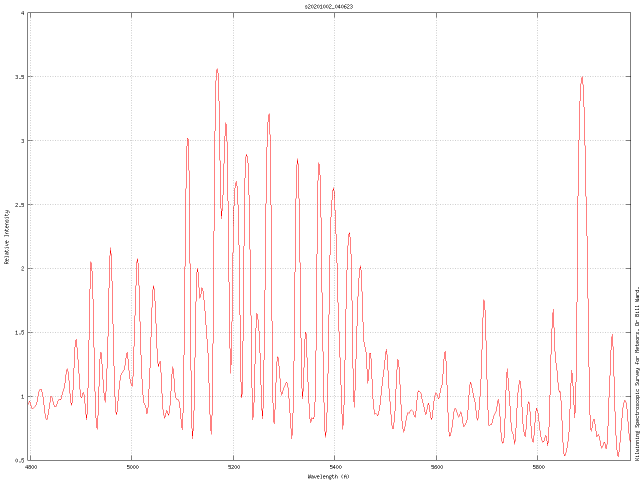
I need a cuppa…
 Bill WardParticipant
Bill WardParticipantHi All,
Yet another extra-ordinary meteor spectrum…, and very similar to the one of this thread!
However, in this case there are some significant differences. There are sodium and magnesium signatures so this one certainly had a more “stoney” feel.

The image actually captures both the first and second orders.
With the extra elements there are lots of lines to identify, graph to follow… ; – )

Cheers,
Bill.
 Bill WardParticipant
Bill WardParticipantHi Jack,
Thanks, yes they are definitely of the same “stuff”. Haven’t heard back from any of the NEMETODE guys if anyone else caught it. An orbit would been most interesting!
I’ve been having a most excellent run of results recently, long may it continue!
Cheers,
Bill.
 Bill WardParticipant
Bill WardParticipantMmmm, no idea why the graphics didn’t appear so here they are again…

October 2015 Fireball.

October 2020 Fireball.
Cheers,
Bill.
 Bill WardParticipant
Bill WardParticipantYou wait for years then several come along…
Caught another two sodium free meteors last night (early this morning)!
The first was the better, in fact a two for one! Got two meteors in the one frame with Taurus providing a nice background.
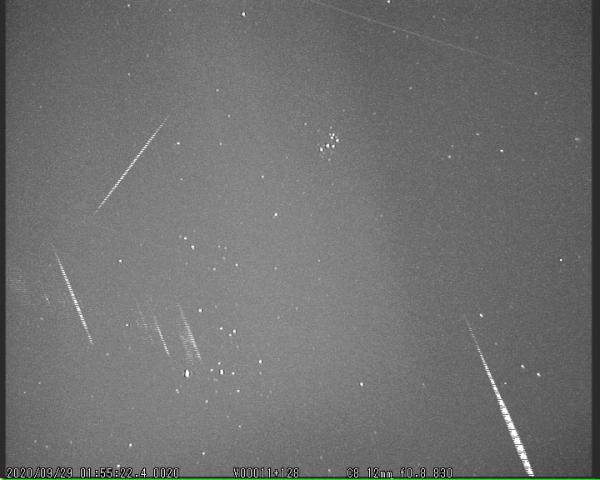
The sodium line should have just peeked into the frame on the far left. Being a touch brighter this spectrum has identifiable Fe lines.The others probably do to but they are just too faint come up in the spectrum. Again the spectrum is dominated by magnesium and calcium.
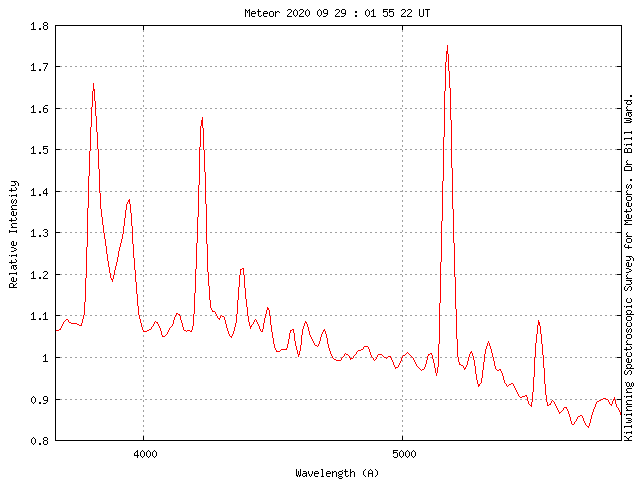
The gents of NEMETODE have a few captures of this one so I’m hoping they can get an orbit!
The other was at 040946 but was faint. Will need a little more work…
The zoo continues to grow!
Cheers,
Bill.
 Bill WardParticipant
Bill WardParticipantHi all,
Clearly these are relatively rare beasts, I caught only my second sodium free meteor a few nights back…
Very similar in composition to the first in this thread, Ca and Mg are the most prominent lines, interestingly the Ca and Mg lines are from neutral atoms the usually bright Ca+ lines in the near UV and the Mg+ line 448.12nm are missing….
Indirectly it was certainly less than 60km/s but an orbit solution would confirm this.
Did any of the NEMETODE team get this one…?
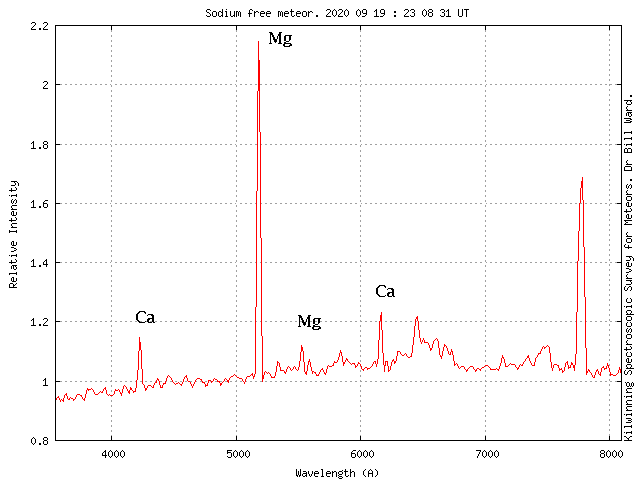

With recent results it is clear we have quite a zoo of micro geology falling on us!
Cheers,
Bill.
 Bill WardParticipant
Bill WardParticipantSince I first discovered these with my narrow field of view experiment I’m now seeing them fairly regularly. This is a short video from the other night with three good examples. The stretch is pretty harsh but the meteor head can be seen to elongate and disintegrate as it ablates. The last of the three takes over two seconds to fully abalate.
Cheers,
Bill.
 Bill WardParticipant
Bill WardParticipantHi Grant,
I was perusing this thread looking for another comment when I saw your question, apologies for the late answer…
The filter was a HOYA HMC circular polariser and yes it’s just an ordinary photographic type as recommended for DSLR’s using autofocus.
It was a fun experiment. Nice to see a bit of theory in practice!
Cheers,
Bill.
 Bill WardParticipant
Bill WardParticipantHi Jack,
Thanks. I have another very hi res spectrum (the Fe one) now with 60+ lines identified. This is currently with John Mason who wanted something for the Observing Notes in the Journal.
We’ll see what appears in the print but I’ll re-post the spectrum graphs here in due course.
Cheers,
Bill.
 Bill WardParticipant
Bill WardParticipantHi,
Here’s a calibrated graph of the spectrum. Had a few headaches with this one as the spectrum isn’t the third order, it’s the second order. A bit of confusion with the image scale after 12+ years of working with spectra from WATECS…
A few “lines”, marked with an * are stellar artifacts and noisy pixels not real lines.
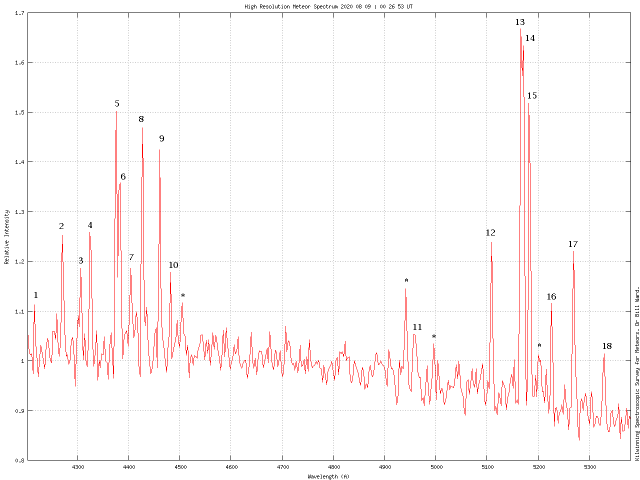
and here’s a list of list of catalogue lines closest to the “barycentre” of the spectrum line (as it’s called in VisualSpec)
Line Wavelength (nm) Element
1: 421.618 Fe I
2: 427.176 Fe I
3: 430.790 Fe I
4: 432.576 Fe I
5: 437.593 Fe I
6: 438.355 Fe I
7: 440.475 Fe I
8: 442.730 Fe I
9: 446.165 Fe I
10: 448.113 Mg II
11: 495.760 Fe I
12: 511.040 Fe I
13: 516.732 Mg I (Probable blend with 516.749nm Fe I)
14: 517.268 Mg I (Probable blend with 517.160nm Fe I)
15: 518.360 Mg I
16: 522.715 Fe I
17: 526.954 Fe I
18: 532.830 Fe IIf the spectrum had been a bit brighter, or shifted to either side a bit, perhaps other lines would have been observed. However as is, it looks like a simple composition of just iron, magnesium and sodium.
Interesting because it is rather un-interesting!
Cheers,
Bill.
 Bill WardParticipant
Bill WardParticipantHi,
I’ve had the radio on in the background for a couple of days, interesting to hear the pings vary throughout the day.
Going to head off to Dumfries and Galloway to seek out any clear skies that may develop. Going to enjoy the show and leave the technology switched off…. well except for the cameras I’ll have, just in case… ; – )
cheers,
Bill.
 Bill WardParticipant
Bill WardParticipantHi all,
After further observations by the NEMETODE guys it appears the meteor wasn’t an Alpha Cap. It now looks like a -4 sporadic fireball of asteroidal origin. So it was indeed a normal chunk of rock…
Cheers,
Bill.
 Bill WardParticipant
Bill WardParticipantHi Alex,
Super results. After the excitement of the weekend, the weather has gone downhill rapidly. Don’t think I’ll get to see much but I’ll be keeping an eye out for any breaks. Although I don’t have the recording running at the moment the I was listening to the GRAVES radar last night, some very strong pings heard.
cheers,
Bill.
 Bill WardParticipant
Bill WardParticipantHi,
Should’ve put the date/time info in the post! No, this was 0026 9th Aug 2020.
Bill.
 Bill WardParticipant
Bill WardParticipantNice! I’d really like to see your “agnostic” circuits.
Cheers,
Bill.
 Bill WardParticipant
Bill WardParticipantNo, it was done with a circular polariser in front of the lens, I don’t have a large enough linear polariser for those lenses.
Anyway, one image is taken as the zero degree image, then the pol is rotated through 45 deg, then another 45 deg, then one more. Giving 0, 45, 90 and 135 degree images. Even that’s not going to be very accurate!
The polarisation functions in IRIS are used to produce the various maps.
Oddly enough on the second night, you could easily see the difference in the various frames due to the sky pol on the camera LCD display. IRIS offers several pol functions but I don’t know how it’s actually determining the various vectors to produce the images.
Everybody seems to get obsessed taking images I just wanted to try something different and see if it would work! The fact that the Rayleigh scattering/polarisation is perpendicular to the solar direction would seem to suggest it was successful after a fashion… but how accurate, who knows! That’s why I say the stronger pol nearer the nucleus could still be an artifact.
Perhaps someone else can try it…?, the comet is still around!
 Bill WardParticipant
Bill WardParticipantHi,
An alternative look at the comet.
The polarisation of sunlight being reflected and scattered by dust particles around the nucleus and in the tail can be easily mapped.
Image one is from a sequence centred on 0050UT 19/7/20.
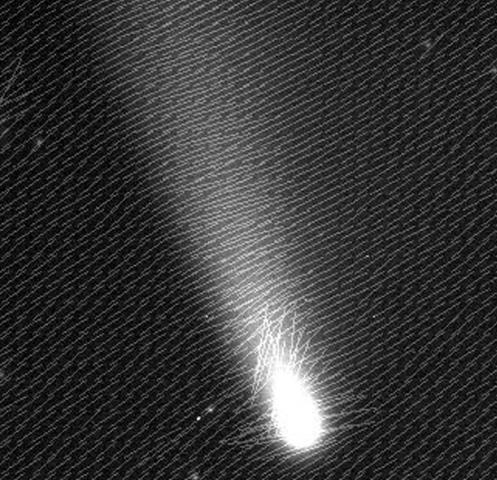
The lines represent the orientation and magnitude of polarisation. The light in the tail is polarised ~4%. There is other stronger polarisation, ~6% across the nucleus, possibly due to a much greater density of particles. additionally there is quite strong polarisation oriented ~60 degrees from the tail polarisation closer to the nucleus.
Initially I wasn’t sure if this was real or an artifact….
Image two is from a sequence centred on 2358UT 23/7/20.
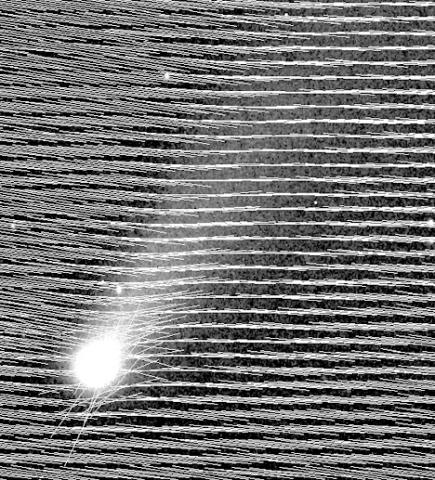
Interestingly, is the stronger polarisation is again seen around the nucleus but with a different orientation and location. It still could be an artifact but it may suggest possible Mie scattering from larger particles. The change in position may be due the rotation of the comet, from a jet or other active area.
Cheers,
Bill.
 Bill WardParticipant
Bill WardParticipantHi all,
Even though it is getting a little darker I’m still struggling with bright twilight when it comes to imaging at my lattitude. This is (an un-corrected in any way!) crop from a shot taken with a FLI KAF39000 camera and a 165 f2.8 lens, 3 x 30 secs through a HMC Y1 Green filter.
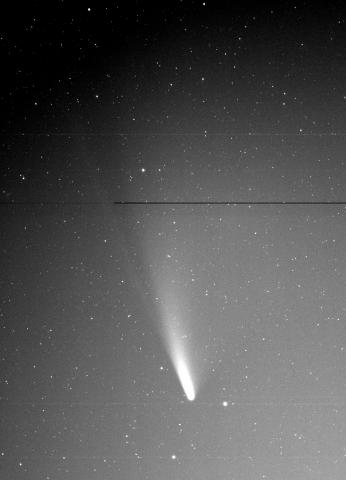
The filter helped take out some of the “blue sky” background. The broadening fan of the dust tail is becoming apparent.
Maybe get to try again in another couple of weeks!
 Bill WardParticipant
Bill WardParticipantHi,
Just found this after posting my reply! Most Excellent! Do you have any spectrum to compare the Na emission to the CN at 388nm?
Cheers,
Bill.
 Bill WardParticipant
Bill WardParticipantHi,
Indeed! A few comments by “science editors” and that’s that! I have no hope of seeing the thing again until this weekend if the weather forecast is to be believed. I was down on the south coast last weekend and it still surprises me the difference a few degrees in latitude makes. I got a view from Tunbridge Wells and it was quite amazing early Sunday morning, sadly I had no gear with me. It also the furthest south I’ve ever seen NLC!
With the sun a little lower maybe get some better images this weekend from back at 55.5N. I’m intrigued by the spectroscopy results from Robin, there are some unusual meteors with extremely high sodium emission too. Whether they are related I’m not sure but it makes the comet even more interesting!
Cheers,
Bill.
-
AuthorPosts
